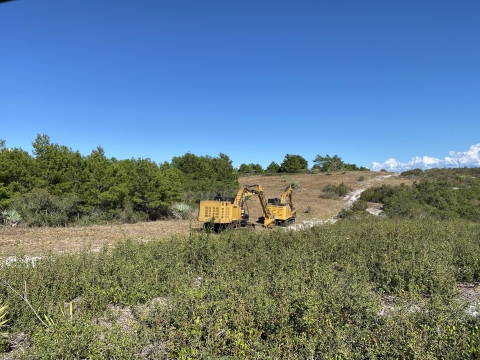Projects and Research
Scrub Habitat Management
A healthy scrub habitat is home to native plants, shrubs, and tree species like the saw palmetto, scrub palmetto, scrub oak, and sand pine. A few of the wildlife species that live and thrive in a scrub habitat are Florida scrub-jays, gopher tortoises, spotted skunks, opossums, raccoons, bobcats, and potentially eastern indigo snakes. Over a period of time, shrubs and trees have become overgrown on the Refuge and that threatens wildlife with a loss of habitat and increases the risk of unwanted fire. The Refuge is planning management activities that includes trimming and mulching with large equipment to restore scrub habitat that will benefit a variety of plants and wildlife, along with reducing the risk of unwanted wildfire. It may look messy at first, but the plants regrow quickly and the payoff will be well worth it.
An Integrated Approach to Managing Scrub
Wildfire once occurred naturally across the Florida landscape, including in the scrub ecosystems found here on the Refuge. Wildfire helped maintain the health and integrity of Florida’s ecology, but in urban areas, fire suppression in natural areas has led to a buildup of overgrown shrubs and trees. Highly combustible fuels (overgrown shrubs and trees) increase the risk of unwanted fire, threatening nearby residents’ property and degrading ecosystem function for wildlife.
On the Refuge, past unwanted fires have closed Federal Highway and threatened nearby residential property. In order to reduce the risk of unwanted fire and provide more suitable habitat for wildlife, the Refuge is using an integrated approach of mechanically treating scrub habitat and where appropriate, utilizing controlled burning. This integrated approach is a proven, safe, and effective way to manage scrub ecosystems.
Healthy scrub:
- Increases potential for utilizing controlled burns
- Increases forest management options
- Has higher biodiversity
- Rare native plants (like scrub mint)
- More suitable habitat for wildlife
Hazardous scrub:
- Increases potential for catastrophic unwanted fires
- Reduces forest management options
- Nuisance plants outcompete desired plants for sunlight
- Less suitable habitat for wildlife
What are mechanical treatments?
Forestry equipment will be used to reduce hazardous fuel loads and allow for better wildlife access and native plant regeneration. Mechanical treatments are often used in situations where overgrown forest conditions hinder our ability to manage forests solely through controlled burning. The equipment used will provide open patches for forest regeneration, which increases forage resources for native wildlife and reduces the threat of unwanted fire.
The remaining mulch will decompose over time putting nutrients back into the soil, and soon after treatment, scrub oaks and other native vegetation will begin to regenerate. It may look messy in the beginning but the payoff to wildlife coupled with reducing the risk of unwanted fire will be well worth it. This process will need to be repeated over time in order for the scrub to be in a state where options such as prescribed burns become available.
Benefits of mechanical treatment
- Reduces the risk of catastrophic unwanted fire threatening nearby residences, power lines and highway infrastructure.
- Creates and maintains scrub habitat for listed species like scrub mint, gopher tortoise, and the Florida scrub jay.
- Allows for future management options
